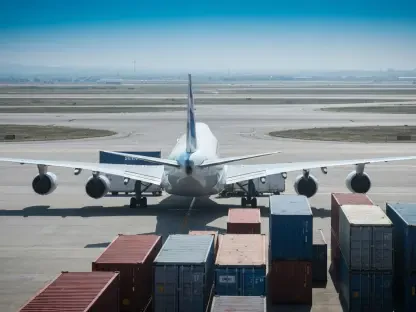As geopolitical crises continue to flare up globally, the maritime industry remains a crucial yet vulnerable sector affected by these upheavals. Political instability, technological advancements in warfare, and shifting economic landscapes contribute to the ongoing challenges faced by maritime routes and operations.
Navigating Through Conflict Zones
The Red Sea Crisis and Its Immediate Impact
Recent geopolitical turmoil, particularly in the Red Sea, has brought to light the vulnerability of maritime operations. The series of Houthi attacks on vessels traversing these waters underscores the significant risks associated with passing through conflict zones. Such events sharply illustrate how political instability in the region can drastically affect the global supply chain, posing immediate threats to the safety of crew and cargo alike. The Red Sea has consequently become a focal point for understanding the broader implications of global political instability on maritime transport.
Shipping companies are compelled to rethink their routes and strategies, balancing the need for economic efficiency with the imperative of safety. These attacks elevate the immediate risks to vessels, demanding swift and substantial responses from maritime operators. Crisis strategies include increased vigilance, the adoption of more robust security measures, and closer coordination with international maritime security agencies. However, the challenges presented are not solely operational but extend to broader economic implications, as the industry grapples with the high costs and inefficiencies born from such geopolitical unrest.
Adaptation Strategies: Rerouting for Safety
Maritime companies have adapted by altering their routes to avoid high-risk areas like the Red Sea. This commonly involves opting for longer yet safer pathways, such as the Cape of Good Hope. While this rerouting underscores the industry’s resilience, it also signifies the readiness of these companies to prioritize safety over traditional economic routes. The move to longer routes is not merely a logistical decision but a strategic adaptation to a rapidly changing threat landscape. The safety of crew and cargo becomes paramount, even if it means compromising on speed and cost-efficiency.
These changes, however, come with significant trade-offs. Longer voyages increase fuel consumption and operational expenses, compelling companies to reassess their financial models and risk calculus. Despite the heightened costs, the industry shows an impressive capacity for flexibility, quickly recalibrating its strategies to navigate these turbulent waters. This adaptability signifies more than an operational shift—it reflects the sector’s broader commitment to safeguarding human lives and valuable assets. Through these adaptation strategies, the maritime industry continuously grapples with an evolving risk environment, ensuring the continuation of global trade even in the face of significant threats.
Economic Implications of Route Alterations
Increased Costs and Operational Shifts
Choosing longer routes such as the Cape of Good Hope inherently increases operational costs. These extended voyages demand more time, fuel, and resources, fundamentally altering the supply and demand balance within the maritime industry. Such operational shifts also contribute to longer shipping times, impacting the timelines of global trade. Consequently, companies must navigate the increased costs that come with these changes, redesigning their logistical frameworks and pricing models to accommodate the new realities.
The economic ramifications extend beyond immediate operational expenses. The global supply chain experiences delays, affecting industries reliant on timely deliveries. The increased duration of voyages translates into delayed shipments, necessitating adjustments in inventory management and procurement strategies for businesses worldwide. Despite these challenges, the maritime industry remains committed to maintaining the flow of goods, demonstrating its resilience and capacity for innovative problem-solving. From a financial perspective, these longer routes introduce new variables into cost structures, but the industry’s robust risk management protocols help mitigate some of these challenges.
The Paradox of Economic Benefits
While increased costs are a direct consequence of longer routes, the paradoxical economic benefit lies in the tightening of supply chains. The increased vessel-day demand often results in higher charter rates, which can be advantageous for shipping operators. This balancing act between heightened costs and potential economic gains adds a complex layer to the industry’s response to geopolitical crises. In this intricate economic dance, higher operational costs are counterbalanced by the opportunity for increased revenue through elevated charter rates.
This paradox illustrates the broader economic dynamics at play within the maritime sector. Operators face a challenging yet lucrative landscape, where resilience and adaptability can translate into tangible financial gains. The tightening of supply chains, driven by extended routes and increased demand for vessels, brings about a new equilibrium. Even as companies absorb higher expenses, the potential for increased earnings provides an economic incentive to adapt swiftly to geopolitical changes. The industry’s ability to navigate this delicate balance is a testament to its strategic agility and economic expertise, allowing it to prosper even amid significant upheaval.
Technological Advancements in Warfare
The Growing Threat of Underwater Drones
Technology continues to evolve, and so do the threats it poses to maritime operations. Underwater drones represent a new level of risk, with potential attacks becoming more sophisticated. As these technological threats grow in complexity, maritime companies are compelled to update their risk assessments continuously, complicating route planning and security measures. The emergence of underwater drones introduces an era of asymmetric warfare, where traditional defense mechanisms may prove inadequate.
The use of underwater drones underscores the heightened sophistication of modern maritime threats. These devices can approach vessels undetected, posing serious risks to both commercial and military ships. The costs associated with deflecting or mitigating such threats further strain the operational budgets of maritime companies. The complexity of these threats demands innovative solutions, pushing the industry to invest in advanced detection and countermeasure technologies. This new technological frontier necessitates a proactive and dynamic approach to maritime security, ensuring the safety of vessels even in increasingly hostile environments.
Enhanced Risk Management Protocols
In response to these increasing technological threats, maritime companies have stepped up their security and risk management protocols. This may involve enhanced monitoring systems, comprehensive threat analysis, and, in extreme cases, the complete avoidance of high-risk zones, despite the economic costs. The adoption of aggressive security measures and innovative technologies plays a crucial role in mitigating these sophisticated threats.
Enhanced risk management includes not only technological upgrades but also strategic collaborations with international security agencies. The integration of advanced surveillance systems, AI-based threat detection, and real-time data analytics allows companies to anticipate and respond to potential threats more effectively. Continuous training for crew members on security protocols further strengthens preparedness against unforeseen incidents. Despite the high economic costs associated with these enhanced measures, the industry’s principal goal remains the protection of human lives and valuable assets, underscoring its unwavering commitment to safety and operational integrity.
Sector-Specific Resilience
Flexibility of Tramp Operators
The maritime industry encompasses a variety of operations, each with its unique set of challenges and adaptive capabilities. Tramp operators, dealing with unscheduled cargo, exhibit greater flexibility in route adjustments. Their ability to swiftly modify operations in response to geopolitical crises underscores a segment of the industry’s adaptability. This flexibility allows tramp operators to navigate volatile environments with greater ease, making rapid decisions to ensure the safety and timely delivery of cargo.
The dynamic nature of tramp operations provides a critical advantage in times of crisis. Unlike liner operators, tramp operators are not bound by fixed schedules, allowing them to reroute on short notice and avoid high-risk zones. This operational fluidity is a significant asset, enabling tramp operators to mitigate risks effectively while maintaining service continuity. Their adaptive responses highlight the sector’s inherent resilience, showcasing how flexibility can serve as a valuable tool in navigating the complexities of geopolitical upheaval.
Challenges for Liner Operators
In contrast, liner operators face more significant challenges due to their fixed schedules and routes. The rigidity in their operations limits their ability to adapt quickly to geopolitical disruptions, making them more vulnerable to delays and increased costs. This variance in operational flexibility highlights the diverse impacts of geopolitical crises across different maritime sectors. Liner operators, bound by predefined schedules and contractual obligations, find it challenging to reroute without substantial economic repercussions.
The fixed nature of liner services amplifies the difficulties they face amid geopolitical crises. Delays caused by route alterations can disrupt entire supply chains, affecting industries dependent on timely deliveries. The economic implications are further compounded by increased fuel costs and extended voyage durations. Liner operators must, therefore, invest heavily in strategic planning and risk management to mitigate these challenges. Despite their limitations, liner operators continue to play a crucial role in global trade, emphasizing the need for innovative solutions to enhance their resilience and adaptability in the face of geopolitical instability.
Resilience and Economic Equilibrium
Rapid Industry Adaptability
Despite the challenges posed by geopolitical crises, the maritime industry showcases remarkable resilience. Companies demonstrate quick adaptability, whether by rerouting, enhancing security measures, or leveraging technological advancements. This agility ensures the continuity of operations in the face of growing threats. The industry’s ability to swiftly pivot in response to evolving geopolitical landscapes underscores its strategic acumen and resourcefulness.
The commitment to innovation and resilience is evident across the sector. From the adoption of cutting-edge technologies to the implementation of robust security protocols, maritime companies can navigate the complexities of geopolitical unrest effectively. This adaptability is not merely reactive but proactive, anticipating potential threats and preparing accordingly. The industry’s collective response exemplifies a blend of strategic foresight and operational flexibility, ensuring that global trade continues unimpeded despite significant challenges.
The Balancing Act of Supply and Demand
Longer routes and increased operational costs may tighten the supply chain, but they also create a balanced demand for vessels. This equilibrium, while challenging to maintain, can lead to higher hire rates and economic benefits for operators. The maritime industry’s ability to navigate this balance amidst geopolitical crises exemplifies its strategic resilience. The intricate dance between cost management and revenue optimization highlights the sector’s economic sophistication.
The economic dynamics within the maritime industry reveal a complex yet resilient ecosystem. Companies must judiciously manage expenses while capitalizing on opportunities for increased revenue. This balancing act requires strategic insight and meticulous planning, ensuring that heightened costs do not erode profitability. The ability to maintain this delicate equilibrium is a testament to the industry’s economic acumen, showcasing how strategic adaptability can transform challenges into opportunities for growth and stability.
Concluding Perspectives
As geopolitical crises continue to erupt across the globe, the maritime industry remains a pivotal but vulnerable sector significantly impacted by these disruptions. Political instability, ranging from regional conflicts to larger international disputes, directly affects maritime trade routes and the security of sea lanes. The rapid advancement of technology in warfare has also introduced modern threats, such as cyberattacks and drone surveillance, which further jeopardize maritime operations. The global economy, marked by fluctuations and shifting alliances, adds another layer of complexity, influencing the stability and efficiency of maritime activities. These intertwined challenges not only pose immediate risks but also necessitate long-term strategic planning and international cooperation among nations to ensure the resilience of maritime trade. Maritime companies must adapt to an ever-changing landscape, balancing the demands of global commerce with the need to protect their assets and crews. Overall, the maritime industry’s ability to navigate these multifaceted challenges will significantly shape its future and its role in the global economy.









